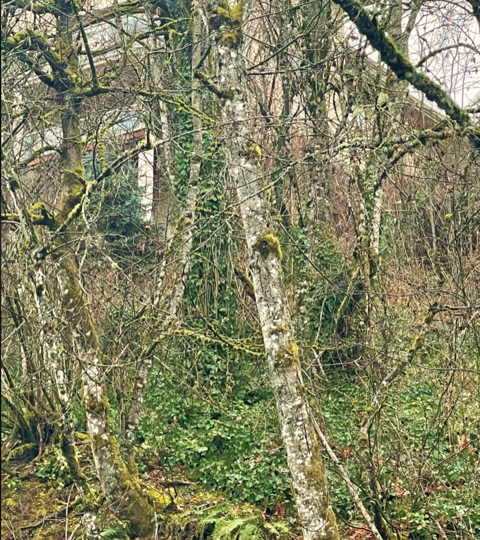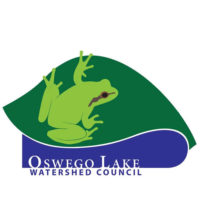MOUNTAIN PARK LAND RESILIENCE PROJECT
The Mountain Park Homeowners Association and the Oswego Lake Watershed Council were awardees of ODF’s 2022 Small Forestland Grant funding. They received a grant for a collaborative urban forestry project designed to reduce the risk of wildfire in the neighborhood of Mountain Park in Lake Oswego.
WHAT WAS THE GOAL OF THE PROGRAM?
The primary goals of the project included reduction of hazardous fuels on common property, invasive species removal, promotion of healthy native plant communities, and supporting the formation of a Firewise community managed by residents of Mountain Park.
WHY DID MOUNTAIN PARK RECEIVE THE GRANT?
When understory vegetation accumulates and ladder fuels build up, they allow fires to burn, ignite and spread faster, leading to high intensity, high impact fires. When fire encounters areas of continuous brush or small trees, especially non native vegetation, it can burn these “ladder fuels” and may quickly move from a ground fire into the treetops, creating crown fires. Steep slopes, dense non-native vegetation, and the interface between wildland and urban areas present high risk for wildfires. The forested area is mainly confined to steep slopes that are topped by the residential areas, increasing the likelihood that a wildfire could develop with catastrophic results to residences – a single cigarette or coal from a barbecue has the potential to start a catastrophic wildfire in these conditions. This forested property also contains invasive plants (including ivy, European clematis, blackberry and invasive tree species) that threaten the resilience of the forest and health of native trees, shrubs, and wildlife within the system.
HOW DOES THE HOA PLAN TO MAINTAIN THE CHANGES TO COMMON PROPERTY?
The Land Resilience Management Plan document found above provides a detailed layout of the work to come.
LAND RESILIENCE RESOURCES
HAZARDOUS FUEL RESOURCES
EXAMPLES OF HAZARDOUS FUELS ON CP
TEST PLOT ON CP AFTER FUEL REMOVAL
WHO IS OVERSEEING THIS PROJECT?
This project will be overseen by the Landscape Stewardship Department in conjunction with the Common Property Committee and Board of Directors.
FIREWISE COMMUNITY PROGRAM
The national Firewise USA® recognition program provides a collaborative framework to help neighbors in a geographic area get organized, find direction, and take action to increase the ignition resistance of their homes and community and to reduce wildfire risks at the local level. Click here to learn more about the Firewise USA® Program.
Sign Up for Wildland-Urban Interface Home Assessment
The Lake Oswego Fire Department also offers assessments for homes in the Wildland-Urban Interface (WUI). Assessments focus on the home ignition zone and provide recommendations on ways to eliminate the fire’s potential relationship with the house.
FREQUENTLY ASKED QUESTIONS
This Frequently Asked Questions Page is an ongoing list of questions and answers intended for Mountain Park residents about the fuel reduction work that will be happening on common property in the Mountain Park neighborhood. If your question is not on this list, please utilize the “Submit A Question” form and your question will be answered at the Public Forums.
Removal of invasive species and promotion of healthy forest successional processes will result in improved ecosystem health and wildlife habitat in the short term and long term. To avoid stress and negative impacts for wildlife, all higher disturbance activities will occur outside of bird nesting season. Best management practices for invasive species removal and habitat enhancement will be utilized.
Ladder fuels, invasive vegetation, and fuel buildups near property lines will be managed. Crews will evaluate 120 acres of common property and remove the most hazardous fuels throughout the project area. For homeowners looking to create defensible space, we have a number of resources (including Firewise and LO Fire Department Assessments) on our web page.
Some replanting may occur in Spring 2023, though Fall 2023 will have a larger planting effort. Native plantings will be able to better establish in cleared areas if planted in fall. We will also be monitoring native seedbank germination and managing invasive weeds in Spring 2023, which may impact planting plans. We are working to create a Management plan that will identify a specific replanting plan. Plantings will be from the City of Lake Oswego’s native plant list.
The wooded area downhill of Hidalgo owned by MPHOA will be included in the treatment area. Kerr Natural Area is also near this area, but it will not be included in this project, though this is a potential target for future fuel reduction efforts.
MPHOA is among 19 other private landowners that received funding through this program this year – we are in the most densely populated area of all grant awardees. MPHOA is considered to be a part of the urban/wildland interface. The high density of single and multifamily housing adjacent to forested open spaces increases the risk of catastrophic wildfire. This area was also identified as a high priority fuel reduction zone in the Clackamas Community Wildfire Protection Plan (CCWPP).
2022 is the first year of the small forestland grant program through Oregon Department of Forestry! Similar projects are occurring throughout our region. Forest Park in Portland is undergoing similar work currently. OLWC has been conducting invasive species removal and restoration projects throughout Lake Oswego – Westlake Oak Woodland is one example of a reference site where fuels have been reduced through habitat enhancement.
The Mountain Park HOA Board of Directors and Staff will continue to support the budgeting for the Landscape Department regardless of the grant.
MPHOA and OLWC staff and volunteers have decades of combined experience in habitat enhancement. In order to increase our training and knowledge base we will be participating in an upcoming Resilient Regenerative Firescaping Qualification Training. We will also receive technical support from local Soil and Water Conservation District Staff and City of Lake Oswego staff. OLWC Executive Director also has an Environmental Science background. Work will occur outside of spring, when trillum are at peak bloom. Work crews will receive plant identification training.
Herbicide will be used selectively. Stumps and small diameter suckers/seedlings will be treated with triclopyr. A tank mix consisting of one part Element 4 and 4 parts W.E.B. oil will be used when the application site is consistent with the product label. Other products may be used at the discretion of the MPHOA and project partners. Basal bark treatments will also be utilized. All herbicide applications will be conducted as specified by the product label and in accordance with state and local laws. Applicators will meet all licensing requirements specified by state law.
Current grant funds cannot be used for long term maintenance activities. OLWC and MPHOA are collaborating on a management plan to identify budgetary needs for maintenance and replanting post-project. We are also identifying potential additional funding sources such as the Oregon Watershed Enhancement Program Small Grant Fund.
No. Native tree removal will only be done when outside of sensitive lands, and to improve conditions for other healthier native trees.
Initial replanting of native species will be focused on sensitive lands and stream corridors. In many cases, natural regeneration of tree, shrub, and forb species is also observed upon removal on non-native vegetation. We are also working to develop a full Maintenance plan that will inform details such as budget, additional grant funding sources, planting lists/timelines, and irrigation strategies.
Yes. Crews will respect property lines and will not remove vegetation on homeowner properties. In cases where privacy hedges provide screening on MPHOA property, there may be opportunities to retain certain ornamental plants if they pose a lower fuel risks and are pruned appropriately
The idea of land resilience and community involvement requires a coupling of social and ecological resilience in rapidly changing landscapes affected by our warming climate. Land management is strongest when it adopts multiple perspectives of resilience. Resilient land that is actively managed using a systems based approach can respond to stress events (drought, extreme weather, fires, insect and pathogen invasions) while supporting wildlife populations, healthy soils, and healthy watersheds.
Yes, native trees from the city of Lake Oswego’s native tree list, such as Western Red Cedar, Douglas fir, Willamette Valley Ponderosa Pine, and Oregon White Oak, will be planted following best practices. These plantings will be focused on sensitive lands and in areas that are lacking species diversity.
No. We are focusing on removal of invasive climbing vines, invasive trees, and invasive shrubs because these are the most hazardous fuels, and negatively impact forest structure. Invasive ground covers will generally not be targeted within the scope of this project, but will be addressed strategically in the future in a methodical manner. Crews will take care to avoid spreading invasive seeds while working by thoroughly cleaning boots, tools, and equipment. Monitoring will be conducted to identify the current extent of priority weed species in order to support future eradication efforts.
No – Treatments will be done by hand crews and will be very selective.
Yes, the work accomplishes what is called for by existing MPHOA Board of Directors adopted policies ( MP Common Property Master Plan 2019-2024). More details can be found in the sections “Invasive Species on Common Property”, “Urban Forest”, “Habitats”, and “Sensitive Lands”
Yes, this project will improve wildlife habitat. Removal of invasive plant species is a key component of this work, which will create more space for native vegetation to thrive. Healthy native plant communities support habitat for insects, birds, and other wildlife.
SUBMIT A QUESTION
Questions/Comments submitted using the “Submit A Question” form above will be collected and answered at the public forums. Frequently asked questions will be added to the FAQ. Thank you for your patience.










